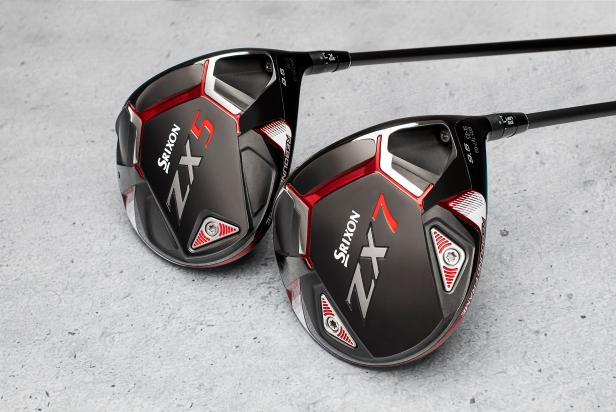Products You May Like
WHAT YOU NEED TO KNOW: Srixon’s new ZX wood family, which includes the low-spin, tour-styled ZX7 driver and the larger footprint, high-launching ZX5 driver along with fairway woods and hybrids, seeks to improve the way the clubface transfers energy to the ball by recalibrating the crown and sole design. With the areas supporting the face flexing, as well, the face can deliver a more powerful hit across a wider area than past models.
Price: ZX7 Driver: $530; ZX5 Driver: $500; ZX fairway woods: $270; ZX hybrids: $230. (In stores Jan. 15)
THE DEEP DIVE: It is easy to get wrapped up in variable thickness flexible titanium alloy faces when we talk about the latest drivers, but have you thought anything about the transition region from the face to the crown and sole, the internal and external radii and thicknesses? Of course you haven’t. Not to worry, Srixon’s engineers and their intense computer modeling have, and the result is the foundation of the new ZX woods.
Leading the way are the ZX7 and ZX5 drivers, which seek to expand the flexing of the face (and the potential for increased ball speed and distance) by focusing on adding flexible and stiffer segments to the regions of the crown and sole that join up with the face. (That focus on the area surrounding the face also has been seen in the company’s recently introduced ZX irons.) Making regions selectively flexible and rigid allows more of the face to deflect, said Jacob Lambeth, research engineer at Cleveland/Srixon.
“Going up to the transition region is where we’ve made big changes,” he said, comparing the new ZX7 and ZX5 to Srixon’s previous generation Z785 and Z585 drivers. “By changing the geometry there, we’re basically creating a second flexible region to help increase the efficiency of energy transfer into the ball.”
The structure of the design, what the Srixon team calls “Rebound Frame,” starts with a proprietary flexible titanium alloy in the face previously seen in the company’s high-end XXIO drivers and last generation’s Srixon drivers. Then it alternates between bands of stiff and flexible sections of titanium toward the front of the crown (including a band of Ti 8-1-1) before transitioning to a larger area of a more rigid carbon composite material across the majority of the crown. Lambeth said the ZX drivers have a crown transition that is 30 percent thinner and a radius that is twice as large compared to past models.
Lambeth said generally drivers have been too stiff in the transition area between face and crown, and the new ZX drivers incorporate a more flexible crown to expand the trampoline effect in the face. The goal is to have the crown and sole meet more like a gentle curve rather than a sharp angle. In a way, he said, the new design’s effect is like imagining a trampoline supported by another larger trampoline. That would increase how high you could bounce as you move closer to the edge of the first trampoline. For a driver, that’s a larger area that’s hotter, too.
“By making the radius of that curve between the face and the start of the crown larger combined with the fact that we’re making this region much thinner, we’re introducing this second flexible area,” he said, noting the construction is now a face insert rather than a cupface to insure the precision of those curves and thicknesses. “Also, this region is lighter so there’s going to be more discretionary mass available to improve performance.”
While the carbon composite used in the crown and wrapping into the toe region of the side skirt is larger and more rigid than past models, it still saves weight that’s redistributed for a lower CG, as well as added perimeter weighting. It also helps build more differentiation between the driver models. The ZX7, which features adjustable heel and toe weights, features a lower center of gravity that’s more forward for lower spin. Meanwhile, the ZX5 features a center of gravity that’s farther toward the back of the club, both compared to the ZX7 and its immediate predecessor, the Z585. That yields a driver that’s more forgiving on off-center hits with more dynamic loft at impact for a higher trajectory than ZX7. Both models use a 12-way adjustable hosel that allows the player to tweak lofts by plus/minus one degree as well as face angle by plus/minus two degrees.
The ZX wood lineup adds fairway woods and hybrids that utilize the same idea from the drivers of alternating stiffness regions in the face transition areas in the crown and sole to enhance energy transfer. The ZX fairway woods include carbon composite crowns on the 13.5 and 15-degree 3-woods. Both the fairway woods and hybrids again make use of a stepdown shape in the crown to help lower the center of gravity for easier launch.
The fairway woods feature a shallower profile than past models, while an internal weight pad in the sole is angled to provide a lower center of gravity and still allow the sole to contribute to the flexing of the face.
Generally targeting average to above average golfers, the ZX7 and ZX5 drivers are offered in 9.5- and 10.5-degree lofts, while the ZX fairway woods and hybrids are offered in four (13.5, 15, 18 and 21 degrees) and five lofts (16, 19, 22, 25 and 28 degrees), respectively. The ZX family of woods will be available for pre-order Jan. 6 and in stores Jan. 15.


